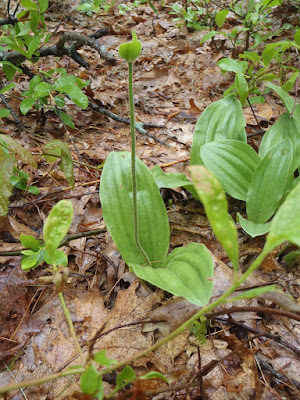Finding myself at home on a school day yesterday meant it was time for a visit to a Wild Place. That is because the best time to visit a Wild Place that is on private property is when decent, hard-working neighbors and their children are at work and school, so that embarrassing questions such as, "who are you? and what are you doing here?" are less likely. The rain today would reduce incidence of passersby still further.
I am, mind you, the perfect ghost at such a time: I make no unnecessary sounds and leaving nothing behind--not even footprints if I can easily manage it.
I first learned of this particular Wild Place in January two winters ago, and returned early the following spring. My most recent visit was last winter, so that all my visits have been outside of the growing season. Leafy vegetation would make it easier to disappear, but also show me a side of the place I hadn't seen.
I made sure to take videos of the view 360 degrees. The first was the shrubby meadow near where I entered. Two others were repeats of ones I had taken last winter, for contrast.
360 from atop the same rockpile as last winter.
After almost two hours in the light rain with temperatures in the mid-fifties, I was ready to go home for a warm shower. But I'll be back.
I am, mind you, the perfect ghost at such a time: I make no unnecessary sounds and leaving nothing behind--not even footprints if I can easily manage it.
I first learned of this particular Wild Place in January two winters ago, and returned early the following spring. My most recent visit was last winter, so that all my visits have been outside of the growing season. Leafy vegetation would make it easier to disappear, but also show me a side of the place I hadn't seen.
I made sure to take videos of the view 360 degrees. The first was the shrubby meadow near where I entered. Two others were repeats of ones I had taken last winter, for contrast.
Open areas are carpeted mostly with huckleberry and blueberry,
but bullbriar also makes you watch your footing.
The high rock pile from which the second video was shot.
The flat rock from which the third video was shot.
One evident difference during the growing that I hadn't anticipated was all the trails. During the snowy winter, only the broadest and most heavily-used trails were visible, but many others were obvious now.
The path system is much more extensive than I'd realized.
An all-terrain vehicle has been through, but either it didn't get far,
I ruminated about my ambivalence toward the local youth's development activities in an earlier post.
That development continues, but for the most part the mess is confined to a few small areas.
(These guys need to learn to make a proper roof.)
(These guys need to learn to make a proper roof.)
A tree stand. Hunting of the local deer is another peeve--pretty unsporting,
given the way Brockton deer have become accustomed to humans.
At the northern end of the wild place is a giant scrape made a few years ago (I'm guessing) by
earth-moving machines--some still parked in a building out of sight. Now it's a lovely meadow.
The eastern edge borders a farm to the north, and a new mcmansion development to the south.
Tilled farmer's field in the distance.
Fog over the farm pond.
The development is out of sight in the distance, but will probably come closer.
The whole shebang.
Despite the "development," I confidently name this a Wild Place not only because of the blueberry and huckleberry thickets, the clubmosses, the sarsaparilla and the ferns, but especially because of the pink ladyslippers. These native orchids are not found where feet trample.
Huckleberry (Gaylussacia baccata) will have sweet but rather seedy berries later in the summer.
Lowbush blueberry (Vaccinium sp. --not V. angustifolium)
Tree clubmoss (Lycopodium obscurum). Despite looking like a tiny pine,
this little plant is more akin to ferns than to conifers or flowering plants.
Wild sarsaparilla (Aralia nudicaulis) grows a single leaf with many parts.
(A single, large triangular leaf fills the foreground, here).
New York fern (Thelypteris noveboracensis) is smallish and delicate, while cinnamon fern (Osmunda cinnamonea) will be much larger when it has reached full size.
Pink lady slipper (Cypripedium acaule) is a native orchid. Each plant has just
two pleated leaves and will bear a single pink flower later in the season.
two pleated leaves and will bear a single pink flower later in the season.
After almost two hours in the light rain with temperatures in the mid-fifties, I was ready to go home for a warm shower. But I'll be back.



























No comments:
Post a Comment